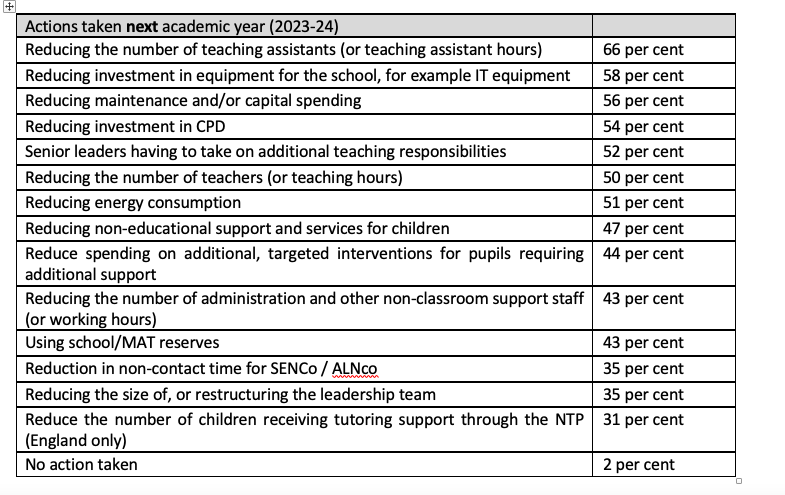
Teaching union NAHT has released the findings from its poll of school leaders, which it claims is the largest ever to be undertaken, with more than 11,000 responses.
The survey highlights the ‘desperate’ cuts schools are having to make in the face of rising costs and Government underfunding, revealing:
- Two-thirds (65 per cent) will have to make teaching assistants redundant or reduce their hours.
- Half are looking at reducing the number of teachers or teaching hours.
- Close to half of schools will have to reduce non-educational support and services for children next year. Including counselling, therapy and mental health support.
- One in four (44 per cent) said they will have to reduce spending on additional targeted interventions for pupils requiring additional support.
- A third (31 per cent) will have to reduce the number of children receiving tutoring support through the National Tutoring Programme (NTP).
'Many thousands of schools are now looking at falling into deficit unless they make swingeing cuts'
Paul Whiteman, NAHT general secretary, said, ‘Schools are being hit by a perfect storm of costs. In attempting to balance their budgets, school leaders are being faced with eye-watering energy bills, spiralling costs to resources and supplies, and the financial impact of an unfunded pay increase this year. With no fat left to cut following a decade of austerity, many thousands of schools are now looking at falling into deficit unless they make swingeing cuts. Education is truly in a perilous state.’
The survey also found that more than half (54 per cent) of schools will go into deficit this year unless they make further cuts, while just 5 per cent of school said they will be able to pay their costs next academic year (23-24) without going into deficit. This means that more than nine in 10 schools won’t be able to balance their budgets without taking action.
'Schools are finding they have no option but to make redundancies'
Whiteman continued, ‘After a decade of austerity, schools have made all the easy savings already. The only things left to cut are things that will have a real immediate impact on children – and especially those who are already the most disadvantaged and vulnerable. This goes against everything school leaders strive for, and the anger and desperation I am hearing from my members is unprecedented.
‘Schools are finding that they have no option but to make redundancies. A reduction in teaching assistants and teachers will be catastrophic, leading to larger class sizes and less support for children with the greatest needs. This cannot be allowed to happen.
‘Having refused to fund the proposed post-Covid recovery plan last year, this Government is effectively abandoning the most vulnerable children in society a second time by decimating the support schools can offer during a renewed time of crisis.
‘We must see urgent action on education spending ahead of the next Budget update.’
The full list of cuts schools are predicting
 The NAHT survey findings reveal what cuts respondents are having to make
The NAHT survey findings reveal what cuts respondents are having to make
A Department for Education spokesperson said, 'We understand the challenges facing schools driven by high inflation. To support them at this time, we are providing schools with £53.8bn this year in core funding, including a cash increase of £4bn for this financial year. This is a 7% per pupil increase in cash terms across schools and high needs.
'All schools will benefit from the Energy Bill Relief Scheme, reducing how much they need to spend on their energy and giving them greater certainty over their budgets over the winter months. We are also providing schools with tools and information to help get the best value for money from their resources.'









